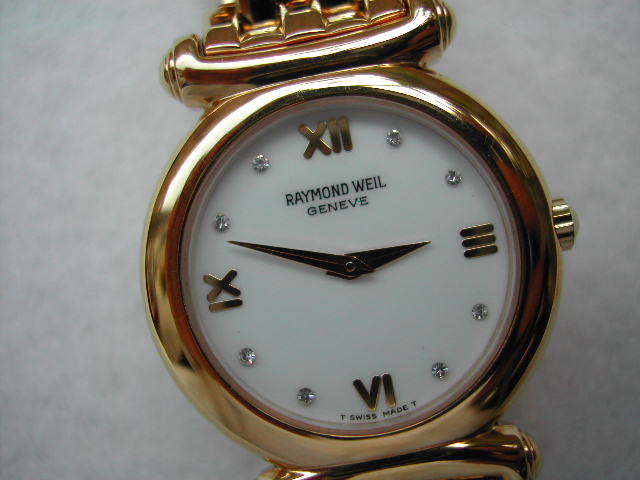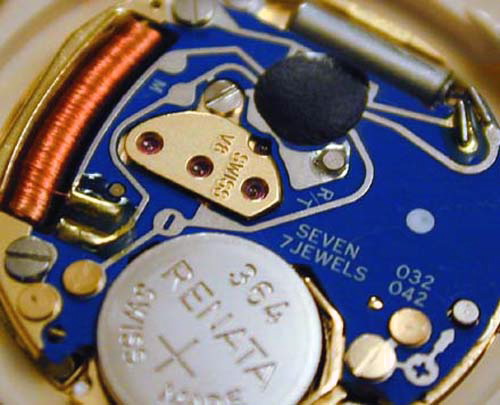
| WWT Shows | CLICK TO: Join and Support Internet Horology Club 185™ | IHC185™ Forums |

|
• Check Out Our... • • TWO Book Offer! • |
Welcome Aboard IHC185™  Internet Horology Club 185
Internet Horology Club 185  IHC185™ Discussion Site Main Page
IHC185™ Discussion Site Main Page  Technical, Shop Talk and Internet Links
Technical, Shop Talk and Internet Links  Watch Repair Questions and Answers
Watch Repair Questions and Answers  Quartz oiling?
Quartz oiling?
 Internet Horology Club 185
Internet Horology Club 185  IHC185™ Discussion Site Main Page
IHC185™ Discussion Site Main Page  Technical, Shop Talk and Internet Links
Technical, Shop Talk and Internet Links  Watch Repair Questions and Answers
Watch Repair Questions and Answers  Quartz oiling?
Quartz oiling?Go  | New Topic  | Find-Or-Search  | Notify  | Tools  | Reply to Post  |  |
Several days ago, I took my Raymond Weil in for a new battery. I've had the watch for several years and I'd say I've worn it 6 or 7 times. I make it a point to pull the stem out so as not to run the battery down. The watch did not run after a new battery was installed. I had their watchmaker check it. Results - dirty contact, so they cleaned contact and oiled the watch. I was surprised to learn a quartz watch needs to be oiled. Are quartz watches taken down as mechnical movements for cleaning and oiling? | |||
|
| IHC President Life Member |
Stephanie, Wheels on automobiles are round because they are made to be driven. Likewise a watch such as you describe will deteriorate more rapidly at rest particularly with the crown pulled out than if it is running. Having the crown in provides at least some protection against the entry of dirt and moisture, an enemies of all machines, yes even quartz-controlled watch movements. Your modern watch has a few moving parts that do require normal periodic maintenance. In fact some of the better quartz watches have high quality jeweled movements. It is not unusual to find seven or more jewels. My personal opinion is to allow battery powered watches to run. If you want yours to rest, remove the battery first and store it in the original box with the crown pushed in. The cleaning of battery contacts was more than likely needed prematurely from the damp climate where you live and may well have been accelerated due to the crown being out. I would not be surprised if there might also be current draw whether the crown is in or out. I know quartz clocks draw when switched off and although they operate on a different principle Accutron Watches "hum" when the crown is out even though the second hand is not moving. I'm sure others may have other opinions on this, but I would not store any battery powered device with the battery inside. Likewise I would be sure to leave the crown in the "pushed in" position unless setting the watch. My style is to when I err, err on the side of caution. My battery powered watches are kept running except for a few that are on display or in storage with the energy cell removed. Oh, and the crown pushed in. Lindell | |||
|
Stephanie, Quartz movements generally need oiled on a less aggressive schedule depending on the composition of the materials and the style. Some with complications will need more frequent service. As Lindell mentioned keep the crown down to keep out dirt and oxidation. David Fahrenholz | ||||
|
Lindell, Thanks for your advice. I will need to leave the crown in the "pushed in" position rather than remove the battery as I am unable to open the back. Any suggestions as to how to open back of watch? Is there a special tool needed? Here's a pic of the back of my watch. Stephanie O'Neil  | ||||
|
and frontal view for those who are interested. Stephanie O'Neil  | ||||
|
David F., Thanks for your info as well. I'm a little curious, how are quartz movements oiled? Do they need to be disassembled as do mechnical movements for oiling? Stephanie O'Neil | ||||
|
and, can anyone tell me how the back of my watch can be removed and, if there is a special tool used to remove back of watch? Stephanie O'Neil | ||||
|
Hi Steph, I can't tell from your pix, but generally watches like yours have a back that just pops off when pried. Look at the back under a loupe. There should be a small lip on the edge of the back plate. Use a knife blade and carefully pop off the back. Be careful not to scratch the case. Also, your watch might have a small rubber waterproof gasket aroung the edge of the case back. Be careful not to damage or wrinkle the gasket, if it is there. Good luck. Tom | ||||
|
Stephanie, If it is indeed a snap back as it appears check for a very slight gap near the lugs. Insert a dull pocket knife or butter knife being careful not to put pressure on the band spring bar. Instead use a very slight twist of the wrist to pop it off. David Fahrenholz | ||||
|
I have a few battery powered quartz watches.I would like to clean them someday and oil them.Could someone give a description of the cleaning and oiling process? | ||||
|
Tom H. & David F., Thanks for info as to how to open back of watch. I decided not to open the back as I did not want to scratch the watch, break a possible rubber gasket or risk not being able to get the back on the watch. Instead, I emailed Raymond Weil website and sent all appropriate numbers that were listed on the back of my watch. I asked if they would find out how many jewels my watch has. I rec'd an email from them yesterday. My quartz watch has 7 jewels! I recently found out that if a quartz watch has no jewels there is no need for a quartz watch to be oiled and cleaning is a mere wipe of the area where the battery is housed. Any other additionals comments on the subject watchmakers? Stephanie O'Neil | ||||
|
I may be wrong on this but i would think that any moving parts would still need cleaning of some kind and lubrication.maybe some of the experts here could comment on this? | ||||
|
Hi Steph, I have never cleaned nor oiled a quartz watch. Of course, the quartz watches that I wear for knock around I have gotten at yard sales or in junk boxes at marts. I have no idea how much one would charge to clean and oil a quartz watch, but I could never justify spending on a watch that did not cost me over a dollar. Of course, your Raymond Weil is the exception. According to my watchmaker friend, as long as it is running and keeping time, don't touch it. The reason for cleaning and oiling is to prevent friction. The movement of the train wheels in a quartz watch is so slow and without pressure from a mainspring. My guess is that an unjeweled pivot in a quartz would show signs of significant wear in maybe 50 years or so. The recommendations from my friends who are in the jewelry trade--open it up to change the battery and leave it alone. Tom | ||||
|
| IHC President Life Member |
All they "cleaned" in Stephanie's watch were the battery contacts. That simple process should always be a routine part of any battery replacement. Tom is right the need for any other maintenance is minimal. Below, here's a typical 7-Jewel Quartz Movement...  | |||
|
Thanks Tom and Lindell, makes more sense now with the explanations. A buddy of mine gave me a seiko chrono to replace the battery he said it just quit. It brought up a interesting question to myself.This Seiko spent most of it,s life in Jamaica, i was thinking probaly a humid climate.When i opened the watch up a fair bit of the greenish corrosion is starting, maybe the salty air also from the ocean probaly does not help much. I will replace the battery and do the necesary cleaning and see what happens. | ||||
|
Kevin, Ocasionally a quartz will get a speck of dust or dirt in the gear train and will stop the watch. The solution for the watchmaker is to put the watch on a machine that spins it a few seconds at high speed which effectively blows out the dirt binding it up. My watchmaker friend has done this for me twice and does it for me for free. The whole process takes about 2-3 minutes. That time includes removing the back, taking out the battery, spinning the watch, replacing the battery, and replacing the back. Regular customers are charged $10 for this. Tom | ||||
|
The real problem with quartz movements is economics. I have serviced them for clients before who were firm in retaining the original movement. There is wear on the train from the stepper motors though but again the cost is a factor. As far spinning the train, it is a good way to determine mechanical soundness BUT imagining the dirt disappeared is not a good practice. I always take the movement down and clean it as quartz movements are fairly simple and in many cases modular assemblies. David Fahrenholz | ||||
|
| Powered by Social Strata |
| Your request is being processed... |
|
©2002-2025 Internet Horology Club 185™ - Lindell V. Riddle President - All Rights Reserved Worldwide

